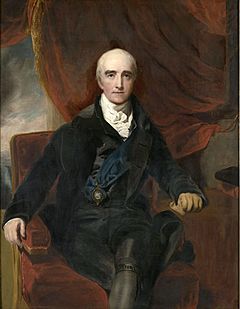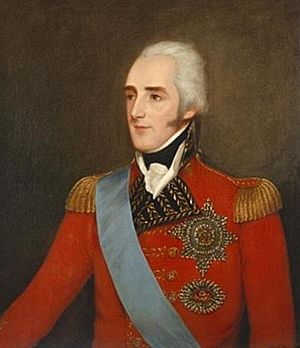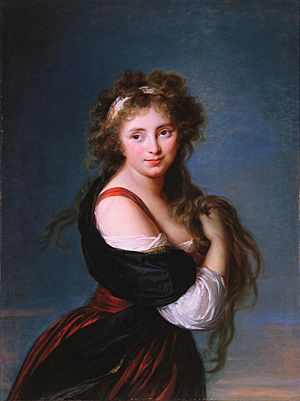Richard Wellesley, 1st Marquess Wellesley facts for kids
Quick facts for kids
The Most Honourable
The Marquess Wellesley
|
|
|---|---|

Portrait from the studio of Thomas Lawrence
|
|
| Lord Lieutenant of Ireland | |
| In office 8 December 1821 – 27 February 1828 |
|
| Monarch | George IV |
| Prime Minister | |
| Preceded by | The Earl Talbot |
| Succeeded by | The Marquess of Anglesey |
| In office 12 September 1833 – November 1834 |
|
| Monarch | William IV |
| Prime Minister | The Earl Grey |
| Preceded by | The Marquess of Anglesey |
| Succeeded by | The Earl of Haddington |
| Secretary of State for Foreign Affairs | |
| In office 6 December 1809 – 4 March 1812 |
|
| Monarch | George III |
| Prime Minister | Spencer Perceval |
| Preceded by | The Earl Bathurst |
| Succeeded by | Viscount Castlereagh |
| Governor-General of the Presidency of Fort William | |
| In office 18 May 1798 – 30 July 1805 |
|
| Monarch | George III |
| Prime Minister | |
| Preceded by | Sir Alured Clarke (provisional) |
| Succeeded by | The Marquess Cornwallis |
| Personal details | |
| Born | 20 June 1760 Dangan Castle, County Meath |
| Died | 26 September 1842 (aged 82) Knightsbridge, London |
| Resting place | Eton College Chapel |
| Nationality | British |
| Political party | Tory |
| Spouses |
|
| Parents |
|
| Alma mater | Christ Church, Oxford |
Richard Colley Wellesley, 1st Marquess Wellesley (born June 20, 1760 – died September 26, 1842) was an important Anglo-Irish politician and leader. He held several key roles during his life. These included serving as the Governor-General of India, the Foreign Secretary for Britain, and the Lord Lieutenant of Ireland.
Richard Wellesley was the older brother of Arthur Wellesley, who became the famous Duke of Wellington. The Duke of Wellington was a great military leader who defeated Napoleon Bonaparte at the Battle of Waterloo. Richard Wellesley was known for expanding British influence in India and for his work in government.
Contents
Early Life and Education
Richard Wellesley was born in 1760 at Dangan Castle in County Meath, Ireland. His family was part of the old Anglo-Irish noble families. He went to several schools, including Harrow School and Eton College. He was very good at studying classical subjects like Latin and Greek. He also studied at Christ Church, Oxford University.
In 1780, he became a member of the Irish House of Commons, which was like a parliament for Ireland. The next year, when his father passed away, he became the 2nd Earl of Mornington. This meant he took a seat in the Irish House of Lords. In 1784, he also joined the British House of Commons. Soon after, he was appointed a Lord of the Treasury by William Pitt the Younger, who was the Prime Minister.
In 1793, he joined the Board of Control, which oversaw affairs in India. This experience helped him prepare for his future role as Governor-General of India.
Leading British India
In 1797, Richard Wellesley accepted the important job of Governor-General of India. He arrived in India in 1798. His main goal was to make sure that French power did not become too strong in India. At this time, Britain and France were rivals in Europe.
War with Mysore

Soon after arriving in India, Wellesley learned that Tipu Sultan, the ruler of Mysore, was trying to form an alliance with France. Wellesley decided to act quickly. He prepared for war and ordered the French troops working for the Nizam of Hyderabad to be disbanded.
In February 1799, Wellesley's forces invaded Mysore. The war ended quickly with the capture of Seringapatam on May 4, 1799. Tipu Sultan was killed during this battle.
Expanding British Influence
Wellesley also started the Second Anglo-Maratha War in 1803. His brother, Arthur Wellesley, played a big part in this war. These wars helped reduce French influence in India. Britain gained more control in central India.
Wellesley was also a very good administrator. He chose his talented brothers, Arthur and Henry, to help him. Arthur was his military advisor, and Henry was his personal secretary.
He founded Fort William College in Calcutta. This college was a training center for British officials who would govern India. He also created the governor-general's office. This office allowed talented civilians from the college to learn about high-level government work directly from him.
Return to Britain
Wellesley's time as Governor-General ended in 1805. He returned to Britain and became involved in British politics again.
Political Roles
In 1809, Wellesley became the British ambassador to Spain. He worked to get the Spanish government to cooperate with his brother, the Duke of Wellington, in the fight against the French.
A few months later, he became the Foreign Secretary. He held this position until 1812. He left this role partly because he felt the government was not supporting Wellington enough. He also strongly believed that Catholic emancipation (giving Catholics equal rights) was very important. Wellesley was a strong supporter of Catholic rights throughout his life.
Family Life

Richard Wellesley married Hyacinthe-Gabrielle Roland in 1794. They had five children together:
- Richard Wellesley (1787–1831), who became a member of parliament.
- Anne Wellesley (1788–1875). Her descendants include King Charles III.
- Hyacinthe Mary Wellesley (1789–1849).
- Gerald Wellesley (1792–1833).
- The Rev. Henry Wellesley (1794–1866).
After his first wife passed away in 1816, he married Marianne (Caton) Patterson in 1825. They did not have children together, but their marriage was a happy one.
Later Life
Lord Lieutenant of Ireland

In 1821, Wellesley was appointed Lord Lieutenant of Ireland. This was a very important role, like a governor, for Ireland. Many people hoped he would help settle the issue of Catholic rights. However, this issue remained unsolved for some time.
When his brother, Arthur Wellesley (the Duke of Wellington), became Prime Minister, Richard resigned from his role as Lord Lieutenant. He was reportedly sad that his brother did not offer him a position in the Cabinet. However, he was happy to see Catholic rights finally granted the next year.
In 1833, he became Lord Lieutenant of Ireland again for a short time. After this, he mostly retired from public life.
Death
Richard Wellesley passed away on September 26, 1842. He was buried at Eton College Chapel, which was his old school. His brother Arthur, who had been distant for some years, was very sad at the funeral. Arthur said that being Richard's brother was the greatest honor he knew.
Legacy
Richard Wellesley's name lives on in several places around the world:
- The Township of Wellesley in Ontario, Canada, is named after him.
- Wellesley Island in the St. Lawrence River, Canada, also bears his name.
- Province Wellesley (now called Seberang Perai) in Penang, Malaysia, was named after him when it was given to the British East India Company.
- The Wellesley Islands off the coast of Queensland, Australia, were named by explorer Matthew Flinders in his honor. The largest island in this group is Mornington Island, also named after him.
- The Mornington Peninsula in Australia, south of Melbourne, is named after him.
- A street in Mirzapur, India, was named Wellesleyganj.
Images for kids








